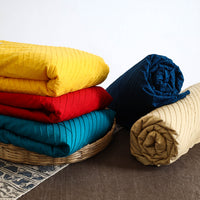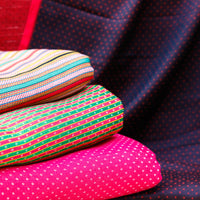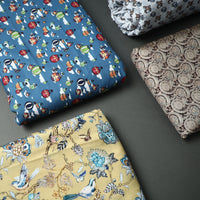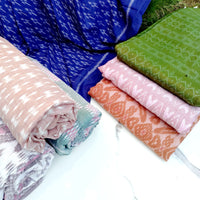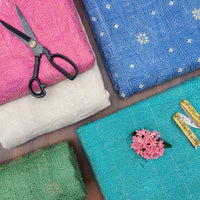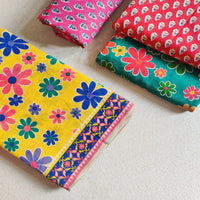The Timeless Art of Shibori: A Journey Through Tradition, Craftsmanship, and Cultural Heritage
Introduction: Discover the Allure of Shibori Fabric
Shibori, a revered fabric dyeing technique, dates back over a thousand years and has traversed continents to become a cherished art form in various cultures. Originating from Japan, Shibori's intricate patterns and rich history have captivated textile enthusiasts worldwide. Today, iTokri proudly presents an exclusive collection of Shibori fabrics that not only embody this ancient art but also carry forward the traditions of the artisans who meticulously craft each piece.
At iTokri, we are committed to bringing you authentic, handcrafted Shibori fabric, sourced directly from the artisans who have perfected this craft over generations. Our platform stands as a bridge between global consumers and the artisans who breathe life into these exquisite textiles, ensuring that the cultural heritage and craftsmanship of Shibori continue to thrive.
The Origins of Shibori: A Craft Rooted in History
Shibori, derived from the Japanese word "shiboru," which means to wring, squeeze, or press, is an ancient resist-dyeing technique. The process involves manipulating the fabric in various ways—tying, folding, twisting, or compressing—before applying dye. This meticulous method creates a range of intricate patterns, each unique and impossible to replicate exactly.
Shibori's roots can be traced back to the 8th century in Japan, where it was first practiced among the lower classes who could not afford to buy expensive fabrics like silk. Instead, they used Shibori techniques to decorate their clothes, giving rise to this distinctive art form. Over time, Shibori evolved from a necessity into a respected craft, practiced by artisans who honed their skills over centuries.
Shibori in India: A Cultural Exchange and Evolution
While Shibori is deeply rooted in Japanese culture, its influence has reached far beyond Japan's borders. India, a land known for its rich textile traditions, embraced Shibori with open arms. The technique found a natural home in India, where it merged with the country’s own vibrant textile heritage.
In regions like Rajasthan and Gujarat, where tie-dye techniques such as Bandhani have been practiced for centuries, Shibori was welcomed as a complementary craft. Indian artisans, known for their ingenuity and artistic flair, began to incorporate Shibori into their repertoire, creating textiles that are as diverse as they are beautiful. The result is a unique blend of Japanese precision and Indian exuberance, seen in the vibrant colors and intricate patterns that define Shibori fabrics today.
The Artisans Behind Shibori: Stories of Skill and Dedication
At the heart of every piece of Shibori fabric lies the skill and dedication of artisans who have spent years mastering this intricate craft. These artisans, many of whom belong to small, rural communities in India, carry forward a legacy that has been passed down through generations. For them, Shibori is not just a craft but a way of life—a means of expressing their creativity and preserving their cultural heritage.
Meet the Artisans:
1. Laxmi Bai from Rajasthan: Laxmi, a third-generation Shibori artist, learned the craft from her mother and grandmother. Living in a small village in Rajasthan, she works with natural dyes and eco-friendly materials, creating vibrant Shibori fabrics that reflect the colors of her desert homeland. For Laxmi, Shibori is a way to keep her family’s traditions alive while supporting her household through the sale of her textiles.
2. Ravi Patel from Gujarat: Ravi is a master craftsman who has been practicing Shibori for over 30 years. His expertise lies in combining traditional Shibori techniques with modern designs, creating textiles that appeal to both traditional and contemporary tastes. Ravi’s workshop employs several artisans from his village, providing them with a sustainable livelihood and the opportunity to learn this ancient craft.
3. Asha Devi from Madhya Pradesh: Asha Devi’s work is a testament to the resilience and creativity of Indian artisans. After losing her husband, Asha turned to Shibori as a means of supporting her family. Today, she is a respected artisan known for her intricate patterns and innovative use of colors. Asha’s story is one of empowerment, showing how traditional crafts can provide not just financial stability but also a sense of purpose and pride.
The Craftsmanship Behind Shibori: Techniques and Processes
The beauty of Shibori lies in its complexity. Each piece of fabric undergoes several stages of preparation, dyeing, and finishing, with artisans carefully controlling each step to achieve the desired patterns. The process begins with the selection of the fabric—typically cotton, silk, or linen—which is then manipulated in various ways to create resist areas where the dye will not penetrate.
Key Techniques:
1. Kanoko Shibori: This technique involves tightly binding small sections of the fabric with thread to create patterns. The fabric is then dyed, with the bound sections resisting the dye and remaining the original color. The result is a pattern of small, intricate circles or dots.
2. Arashi Shibori: Known as pole-wrapping Shibori, this technique involves wrapping the fabric around a pole, which is then bound tightly with thread. The pole is twisted as the fabric is dyed, creating diagonal or wave-like patterns reminiscent of rain (hence the name "Arashi," which means storm in Japanese).
3. Itajime Shibori: In this technique, the fabric is folded and then clamped between two pieces of wood before dyeing. The areas that are clamped resist the dye, resulting in geometric patterns.
4. Kumo Shibori: This technique involves pleating and binding the fabric in multiple places, creating spider-like patterns. The term "Kumo" means spider in Japanese, reflecting the intricate, web-like designs produced by this method.
The Shibori Fabric Collection at iTokri: Tradition Meets Modernity
iTokri’s Shibori fabric collection is a celebration of this ancient craft, offering a range of textiles that combine traditional techniques with contemporary designs. Each piece is a work of art, showcasing the skill of the artisans who create them and the rich cultural heritage they represent.
Featured Fabrics:
1. Shibori Silk Fabric: Our Shibori silk fabrics are perfect for those looking to add a touch of luxury to their wardrobe. The smooth, lustrous texture of silk, combined with the intricate patterns of Shibori, creates textiles that are both elegant and timeless.
2. Cotton Shibori Fabric: Ideal for everyday wear, our cotton Shibori fabrics are lightweight, breathable, and versatile. Whether used for clothing, home decor, or accessories, these fabrics bring a touch of artistry to any setting.
3. Shibori Tie-Dye Fabric: For those who love bold, vibrant colors, our Shibori tie-dye fabrics are a must-see. These textiles are dyed using natural pigments, ensuring that each piece is not only beautiful but also eco-friendly.
4. Shibori Print Fabric: Our collection also includes Shibori print fabrics, which offer the same stunning patterns as traditional Shibori, but with the convenience of modern printing techniques. These fabrics are perfect for those who want the Shibori look without the premium price.
iTokri’s Commitment to Sustainability and Cultural Preservation
At iTokri, we believe that every purchase should make a positive impact. That’s why we are dedicated to supporting the artisans who create our Shibori fabrics, ensuring that they receive fair compensation for their work and have the resources they need to continue practicing their craft. We also prioritize sustainability in every aspect of our business, from using recycled materials in our packaging to supporting eco-friendly dyeing practices.
By choosing to shop at iTokri, you are not just buying a piece of fabric—you are becoming part of a movement to preserve traditional crafts, support artisan communities, and promote sustainable practices. Our Shibori fabrics are more than just textiles; they are a testament to the skill, creativity, and resilience of the artisans who create them.
Join the iTokri Family:
Experience the warmth of Indian hospitality and the luxury of genuine handcrafted products at iTokri. Each item tells a story of skill, tradition, and a passion for sustainable art. Shop with us and be part of a movement that values beauty, craftsmanship, and a brighter future for artisans across India.
Conclusion: Why Choose iTokri for Shibori Fabric?
When you choose iTokri, you are choosing authenticity, quality, and a commitment to making a difference. Our Shibori fabric collection is a reflection of our dedication to preserving traditional crafts and supporting the artisans who create them. With a focus on sustainability, cultural preservation, and community engagement, iTokri is more than just a marketplace—it’s a platform for artisans to share their stories and for customers to connect with the rich cultural heritage of India.
Whether you’re an art enthusiast, a fashion designer, or simply someone who appreciates the beauty of handcrafted textiles, iTokri’s Shibori fabric collection has something for you. Explore our range today and discover the timeless beauty of Shibori—an art form that continues to inspire and captivate, just as it has for centuries.
शिबोरी की कालातीत कला: परंपरा, शिल्पकला, और सांस्कृतिक विरासत की यात्रा
परिचय: शिबोरी कपड़े का आकर्षण
शिबोरी एक प्राचीन फैब्रिक डाईंग तकनीक है जो जापान से उत्पन्न हुई है और दुनिया भर में अपनी समृद्ध इतिहास और जटिल डिजाइनों के कारण प्रसिद्ध है। आज, iTokri आपको इस प्राचीन कला का प्रतिनिधित्व करने वाले शिबोरी फैब्रिक्स का एक विशेष संग्रह प्रस्तुत करता है, जो कुशल कारीगरों द्वारा हाथ से बनाए गए हैं। हम इस सांस्कृतिक धरोहर और शिल्पकला को जीवित रखने के लिए प्रतिबद्ध हैं।
शिबोरी की उत्पत्ति: इतिहास में जड़ें
शिबोरी का अर्थ जापानी शब्द "शिबोरु" से है, जिसका मतलब होता है निचोड़ना, दबाना या मोड़ना। यह एक प्राचीन रेजिस्ट-डाईंग तकनीक है जिसमें कपड़े को विभिन्न तरीकों से बांधकर या मोड़कर डाई किया जाता है, जिससे अद्वितीय और जटिल डिज़ाइन बनते हैं। शिबोरी की शुरुआत 8वीं सदी के जापान में हुई थी और समय के साथ यह एक सम्मानित कला के रूप में विकसित हुई।
भारत में शिबोरी: एक सांस्कृतिक आदान-प्रदान और विकास
हालांकि शिबोरी जापान की देन है, लेकिन इसने भारत में भी अपनी जगह बनाई है। राजस्थान और गुजरात जैसे क्षेत्रों में जहां बंधनी जैसी तकनीकें पहले से ही प्रचलित थीं, शिबोरी ने एक पूरक कला के रूप में प्रवेश किया। भारतीय कारीगरों ने शिबोरी को अपने शिल्प में शामिल किया, जिससे कपड़ों में जापानी परिशुद्धता और भारतीय जीवंतता का अद्वितीय मिश्रण देखने को मिलता है।
शिबोरी फैब्रिक संग्रह: परंपरा और आधुनिकता का संगम
iTokri का शिबोरी फैब्रिक संग्रह इस प्राचीन शिल्प का उत्सव है, जो पारंपरिक तकनीकों और समकालीन डिजाइनों का संयोजन है। हमारे पास शिबोरी सिल्क, कॉटन, और प्रिंटेड फैब्रिक्स की विविधता है, जो हर अवसर के लिए उपयुक्त हैं। हम न केवल कारीगरों का समर्थन करते हैं बल्कि स्थिरता और सांस्कृतिक संरक्षण के प्रति भी प्रतिबद्ध हैं।
iTokri से शिबोरी फैब्रिक खरीदना सिर्फ कपड़े खरीदना नहीं है; यह पारंपरिक शिल्पों के संरक्षण, कारीगर समुदायों के समर्थन, और स्थायी प्रथाओं को बढ़ावा देने का एक हिस्सा बनने का अवसर है।
निष्कर्ष: iTokri क्यों चुनें?
iTokri में शिबोरी फैब्रिक का चयन करने का मतलब है कि आप प्रामाणिकता, गुणवत्ता, और एक बेहतर समाज के प्रति हमारी प्रतिबद्धता का समर्थन कर रहे हैं। हमारे कारीगरों की कहानियों से जुड़ने और भारतीय सांस्कृतिक धरोहर को सम्मान देने के लिए आज ही हमारे शिबोरी फैब्रिक संग्रह का अन्वेषण करें।

















